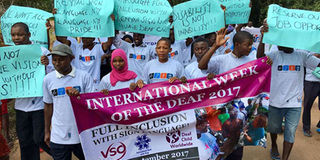Breaking News: At least 10 feared to have drowned in Makueni river
Let us treat the deaf with equal respect, all they need is support

Kenyans mark the International Week of the Deaf in 2017. PHOTO | FILE | NATION MEDIA GROUP
What you need to know:
- The deaf, whether a child or adult, may be in the minority group of the disabled, but they are a unique lingual group of people worth every commendation.
- If we are to hold true to the theme of “With Sign Language Everyone is Included”, everybody willing to learn should be granted the opportunity.
Do you ever notice the interpreter at the bottom of your TV screen or have they become yet another feature accompanying the closed captions?
Have they become like signs, which are everywhere, telling us where to go, what not to touch, what not to do and what the limits are?
But then again, some signs are heavenly; a drifting cloud, a voice from above, or a descending dove. They all tell us something if we look hard enough.
That said, the most distinct signs are from our face; a raised eyebrow, a frown or a sparkle in the eye.
Signs often speaker louder than words can or come in handy where words fail us. There are even languages to accompany these signs; 300 of them.
They are not phonetic with waves and sounds, but are every bit a language as English or your mother tongue. They are sign languages.
DEAF
For the first time, the world will mark the International Sign Language Day tomorrow under the theme “with sign language everyone is included.”
As human beings we are not easily defeated by our circumstances. We adapt and rise above our challenges.
The deaf among us did not swear off communicating because they could not hear or be understood.
Their mode of communication could not conform to the norm, so they changed it. For all the want in the world, they could not merge with the hearing and be part of a society where they are obviously excluded.
Ingenuously, they created a new language, their own, and this is what we call sign language. Their bodies became their voices.
It is probable that a sign used within the family was acquired and became the sign language of a village.
Gradually the deaf community sign language was adapted by other village communities, leading to the birth of a worldwide language.
SPECIAL
Even though they are highly capable we still view the deaf as disabled and thus discriminate against them.
Why? To be so innovative as to create a language and yet be viewed as lesser beings must be perplexing to the deaf.
It must be more perplexing for the children of the deaf, who must rise above and beyond the challenges of their peers to acquire a sign language with which to communicate with their parents.
This, in addition to learning the spoken languages. Their entire childhood, they interpret to their parents while in public events, family gatherings or where there is no accompanying interpreter on the pulpit.
Such children shouldn’t have to watch their parents suffer from being denied employment simply because their mode of communication differs.
Conversely for the parents of deaf children, they too adapt and learn a new language.
SUPPORT
The deaf, whether a child or adult, may be in the minority group of the disabled, but they are a unique lingual group of people worth every commendation.
They are our fellow citizens and what they are in dire need of is support and encouragement.
Reports show that most deaf children score less than 100 marks in their KCPE results. “There is only one PhD deaf graduate, less than eight with a Master’s degree and close to 30 undergraduates,’’ Rose Nyagwoka, the programme officer, Deaf Child Worldwide, said last year.
How then can we be more inclusive of deaf children in our education system? Let’s start with answering the basic questions.
Are nursery schoolteachers taught to spot children with hearing difficulties? Let it not always be assumed deafness only arises from birth.
Sadly, loss of hearing does occur as children grow up. Do we have enough teachers trained in sign language?
TEACHERS
If we are to hold true to the theme of “With Sign Language Everyone is Included”, everybody willing to learn should be granted the opportunity.
Do schools cater to the deaf? And how easily accessible is learning of sign language for parents of such children?
These are questions that, if positively checked, will go a long way in empowering the deaf in our country, increasing the quality in their education and eventually translating to the number of graduates.
As we mark the first International Sign Language Day and International Week of the Deaf from Monday, let us work towards inclusivity.
We should all look forward to the day the Cabinet will include a disabilities Cabinet Secretary. A day the Head of State will begin a speech with a greeting in sign language just like they do with other national languages.
A week of the deaf where television presenters will not leave it up to the interpreter, but they too will speak in sign even if just to say hello to their viewers.
Burini works with international businesses on commercial litigation. gladysburini1@gmail.





